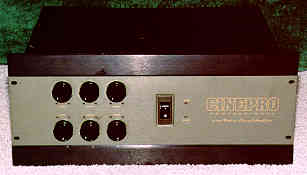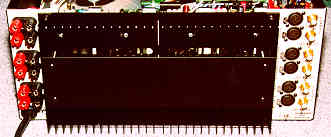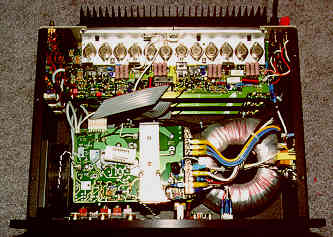Product Review - CinePro 3k6 Six Channel
Power Amplifier - January, 1998
Karl Suager
![]()
 |
CinePro 3k6 Six Channel Power
Amplifier 350 watts/channel rms continuous into 8 Ohms FR: 2 Hz - 150 kHz � 3 dB THD < 0.015% Size: 8"H x 19"W x 16"D Weight: 70 pounds Price: $3,495 USA
|
| Cinepro, 1030 Vicente, San Francisco, California 94116; Phone 1-800-395-1222; E-Mail for literature requests: [email protected]; Web: http://www.cinepro.com |
What could you possibly do with 3,000 watts of power? (CinePro rates their amplifiers into 4 Ohms, since they started out making them for professional uses, where 4 Ohms is the norm. The 3k6 is rated at 500 watts/ch rms continuous into 4 Ohms.) Need I ask the question? Use it, of course! With modern recordings capable of stunning dynamic range, the moderate efficiency of today’s high-performance direct-radiationg (non-compression driver) loudspeakers, and a trend away from the bass-shy neutered mixes of the days when vinyl ruled the earth, too much clean power is an oxymoron.
Let’s get this out in the open from the beginning. I believe in muscle tied with sinew to finesse. Keep the gross levels of distortion in the outboard processors and vintage guitar amps. Asymmetrical non-linearities, parasitic oscillations, weirdly shaped distortion spectra, instability into reactive loads, intermodulation of RF into the audible band, and "clipping", are beasties that I’d remain rather happy doing without. I’m glad to say that although amplifiers relatively free from the afore mentioned aren’t necessarily dirt cheap, I’m lucky enough to have found a few that mortals can afford. Ironically, even though the virtue of real transparency may pass unnoticed by the warped perspective, many of these mundane "bargains" outclass, and even occasionally blow away their esoteric competition. And where does it all start? Power supply, power supply, POWER SUPPLY!
It’s no guarantee that a massive, continuously filling reservoir of stable, raw energy will necessarily equate to great sound. Aside from providing power, an amplifier must maintain stability, low distortion, linearity, and gradually taper its high frequency (HF) response to avoid ultrasonic oscillation-causing phase errors while maintaining a wide bandwidth. The real trick is to do it with reactive loads, like real loudspeakers. Because of this, even if a great power supply doesn’t promise a superb amplifier, an amplifier with a power supply less than adequate for a particular loudspeaker impedance and output level IS guaranteed to, well, suck. Regardless of clipping, IM distortion, phase response, or bandwidth, clipping sounds bad. To avoid clipping, you need two basic things, voltage and current, and that all begins at the power supply.
If the power supply can’t provide the voltage levels required of the output, or the current promised by the voltage to drive the load, the power amp’s sound, without a doubt, gets a big fat F for failure.
I’m not saying that everyone needs multiple kilowatt transformers and hundreds of thousands of micro-Farads (�F) of filter capacitance. But, if you like dynamic material at frighteningly realistic levels through less than the most efficient speakers, it certainly doesn’t hurt, and more than likely does quite a bit of good. The Cinepro 3k6 is just that, quite a bit of good. Heck, it’s a whole heap of goodness.
From a glance at the front face-plate, it looks . . . errr . . .
professional. Six knobs, a power button, and 14 small LEDs reside on a gray, silk-screened
face plate, framed top and bottom by brushed, black metal. The LEDs serve to indicate the
presence of a signal at any of the individual channels, clipping of the same, power
status, and protection circuit use. I would inject that throughout the evaluation, only
the power and signal indicator LEDs came on. The left side contains a cooling fan which
supposedly turns on in more drastic conditions, although I never witnessed its operation.  Looking at the rear,
toggle switches set the use of either the single-ended or balanced inputs located on the
right, while also offering bridging of the channel pairs labeled Left/Right Front,
Left/Right Rear, & Center/Sub. Five-way binding post outputs, slightly cramped, sit on
the left side of the rear panel. Because of the close proximity of the output posts,
I’d really recommend using banana plugs, as they tend to fit into nooks and crannies.
The majority of space is occupied by large heat sinks that plant their big tails between
the inputs and outputs.
Looking at the rear,
toggle switches set the use of either the single-ended or balanced inputs located on the
right, while also offering bridging of the channel pairs labeled Left/Right Front,
Left/Right Rear, & Center/Sub. Five-way binding post outputs, slightly cramped, sit on
the left side of the rear panel. Because of the close proximity of the output posts,
I’d really recommend using banana plugs, as they tend to fit into nooks and crannies.
The majority of space is occupied by large heat sinks that plant their big tails between
the inputs and outputs.
Inside is where this amp really begins to look impressive. For those
interested, the internal layout is neat, simple, and crowded with goodies. With an unGodly
toroidal transformer, 120,000 �F of filter capacitance, and �95 volt rails, it delivers,
without straining, 350 watts into 8 Ohms, and 500 watts into 4 Ohms with all
six channels operating. There are 1,050 Joules of energy storage just
waiting to send those bass drums into your wall studs, courtesy of six bipolar output
devices per channel. 
The output sections use output inductors to ensure stability into reactive loads at ultrasonic frequencies. Theoretically, this could cause minor phase shifts in the audible band, but it's a minor drawback considering the possible alternative. If an amplifier's circuit design uses global feedback without an output network for the sake of bandwidth specifications, or to tailor a rising response for a more lively sound, it might lead to problems. Amplifiers with response peaks have poor phase response within the top of their bandwidth, which leaves them open to oscillation with reactive loads and, occasionally, catastrophic failure. Is an output inductor a compromise? Maybe. Significant? The CinePro 3k6 still has a wider bandwidth than many highly regarded amplifiers without output inductors, so I'd lean towards not very (significant, that is).
The CinePro isn’t just another pretty face with no guts. It's a simple, dependable design. Input driver stages, and outputs, mounted to the rear panel, share a large central power supply. It isn’t dual-mono, or hexa-mono for that matter, which does introduce some theoretical cross-talk compromises, but also comes with its own advantages. The ability to share a single power source allows extra juice, beyond a channel’s normal share, to be allocated where the need demands it most.
For instance, even though digital 5.1 surround formats may occasionally take advantage of the dynamic capabilities of rear channels, seldom do the front and rear channels simultaneously require full output. With the power reserves of this amp, you could drive all channels to ridiculous output levels at once, but it probably won't occur in the real world, and if it does, you might think you are on a different planet. The power supply is capable of delivering three thousand watts to six channels (500 watts each) at 4 Ohms, and when combined with the quality of parts and competent circuit design, makes the performance of this amplifier in two-channel listening not only very good, but almost astounding.
For a two-channel comparison, I used my Aragon 8008BB, a dual-monobloc, single-chassis amplifier. Although the transformers aren’t up to the task of continuously supplying a combined 3000 watts, the two amps have a comparable set of gonads. The Aragon carries slightly lower voltage on the power rails than the CinePro, and slightly more total filter capacitance. In my own opinion, at all but the highest output levels, the 8008BB ranks among the best amplifiers made, where personal preference becomes as relevant as any objective parameter. It is completely unforgiving, sometimes analytical, completely flat, sometimes dry, and yes, with certain material, bright. But as I see it, if it’s bright, hey, it’s bright. It won’t arc weld like the larger Krells, nor does it quite the reach the almost limitless dynamic capabilities of the Llano SA-3 monoblocs in the lab, but for the most part, it is, to use an often inappropriately overused word, transparent. So now that you know my slant, how does the Cinepro 3k6 compare? Not surprisingly, very similar.
In fact, at first I started kicking myself when I realized I could have had more power in six channels for 50% more cost than my favorite two-channel amp. I couldn’t deny it, this gray and black box, without snobbish pretense, was damn good. Great in fact. I switched back and forth between the two, using various listening material, mainly an acoustic Celtic Folk Music compilation disc "Celtic Odessy" and a superbly mixed Dire Straits CD, "On Every Street." As these recordings have exemplary depth information, and the fragile nature of stereo makes subtle equipment performance differences more apparent by the portrayal of ambient cues, they proved invaluable tools.
As I’ve said, the two amplfiers didn’t sound dramatically, night and day different. Accurate amplifiers don’t. But, as amplifiers, like anything else in life, aren’t perfect, neither do they sound exactly the same. Even though the Aragon suited my personal taste a tad more, I can’t really say one sounded decisively better than the other. The Aragon did have a little more sense of air and texture in the higher octaves, and more precise depth overall, but the CinePro countered with a lively, engaging presence in the mid-range. Bass performance, I couldn’t really characterize very different at all. If forced into a statement, perhaps one could compare the character of the Aragon’s bass as over there everywhere vs. the CinePro’s most definitely here, a comparison I feel funny making since I’m not even sure it exists. Placement of instruments and vocalists leaned a little more forward with the CinePro, as it tended to throw everything out at the listener, while the Aragon just let things lay and happen. One sounded effortless, the other, without effort. Need I stress the subtle nature of the distinction?
The CinePro did hold a key advantage over my 8008BB in one area, output capability. I want to keep my hearing, so I don’t usually listen loud enough to use even half the power available from either of these amplifiers, but for this review I gave it a go. With no signal attenuation from a line-level source (CD), which has a maximum output level of 2 volts, I could manage to eek a small clip now and then from the 8008. Try as I might, the CinePro refused to flinch. My woofers, already equipped internally with high-pass filters at 27Hz, began to bottom out as JEJ and I could only look at each other and laugh, "Six channels of this for how much? Oh, my gawd."
Even if you’re not into surround sound yet, 6 channels do lend advantages, like tri-amping. Pick your combination: Passive Tri-amping (if the speakers have the binding posts available)/ Passive bi-amping of two main channels, active x-over for stereo subwoofers/ Full active tri-amping (DIY enthusiasts come to mind), or any combination you can think of. Besides, if you’re a die-hard stereo fan who takes a change of heart, you’re only a few speakers and a processor away from a complete conversion, without compromising audio quality. Sounds like a win-win situation to me. JJ used the 3k6 to passively tri-amp his Krix Esoterix MK-II speakers (which have three sets of binding posts for this purpose). Having 350 watts to drive the tweeter, 350 for the mid-range, and 350 for the woofer in each enclosure, is shall we say, breathtaking.
Needless to say, the CinePro excels in surround sound duty. The real feature here is the clean, clear power, not the itty, bitty, spatial nuances that two-channel applications seem to require due to the delicate (but disturbingly moving at its best) nature of the stereo format. With movie soundtracks, little of the sound is real to begin with. Of course, you can use the 3k6 for two channel applications if you have tri-ampable speakers. In surround settings, although the sound quality of the amplifier is important, I find the digital processing and speakers themselves offer the greatest sonic differences. Although it absolutely improved the performance of the Denon AVR-3200 and my Yamaha DSP E-1000, I’m sorry that I didn’t have a top-notch separate digital processor on hand to let this baby really whip it out. Once an amplifier reaches a caliber like this, straight-forward clarity and dynamic ease is all you can ask for. In these aspects, the 3k6 just glides on through. I’ve never had this much power in a surround system before, and I might just weep when the Editor-in-Chief comes to my door to take it away. Let’s just say I’ve grown attached.
It’s still not cheap, by any means, so I wouldn’t advise blowing the majority of your budget on this amp to leave less than the same amount on your subwoofers and speakers, especially if you don’t really crank it, because the same clarity can be had for less if you’re willing to sacrifice the lion’s share of power. If, on the other hand, you’ve got some speakers with dynamic potential you’d like to unleash, the 3k6 is the first in line. Incidentally, it’s the only 6 channel amp I know of that I’d feel comfortable driving a serious passive subwoofer, or multiple subs, with the single channel. The subwoofer is, after all, the foundation of Home Theater. Skimp on the sub and you’ll be sorry.
So, where are we now? It sounds great. The price, given the performance, leaves nothing to get picky about. Despite my efforts, I can’t arrive at a significant, solid, honest, negative (we are very conservative here at Secrets). In fact, it's definitely a big positive. If you have the funds to afford one (or God help you, two) of these gems, have a largish listening room, top-notch loudspeakers, and a craving for a display of power so vulgar it can make you giddy, haul one of these home and give it a try. If you do, remember to lift with your legs. Good power amps are heavy.
Karl Suager
Associated Components:
Infinity Renaissance 90 Loudspeakers
NEAR 15Ms, 10Ms, and JIB Center channel
M&K S-85 & s-80 satellite speakers
Aragon 8008BB power amplifier
Passive controller w/50 k Nobel Pot
DH Labs Silver Sonic interconnects & speaker cable
Bybee/Curl prototype power purifiers
API Power Pack V AC line conditioner
Denon AVR-3200
![]()
� Copyright 1998 Secrets of Home Theater & High
Fidelity
Return to Table of Contents for this Issue.

